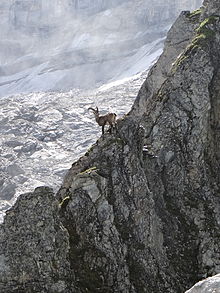I was an Ibex ambitious
To dive over chasms auspicious;
He would leap down a peak
And not light for a week,
And swear that the jump was delicious.
Billy’s Alphabetical Animal Show – James Whitcomb Riley
Also known as the steinbock or bouquetin, this is a species of wild goat found in the Alps of Europe. It’s kind of hard to misidentify with the huge horns of the male. Females sport smaller horns. Males weigh about 220 lbs. and females are about half this weight. Males are only about 3.5 ft. tall and 5 ft. long. They have short coats that vary in color from reddish brown in winter to brownish gray during the summer. The males have a chin beard.


Typically, ibex is found along the craggy terrain between timber and snow lines above the alpine forests of the Alps at elevations between 6,500 – 15,000 ft. Their diet includes grass, flowers, shrub shoots, and moss. Often they can be seen grazing in high meadows in later afternoon or evening and retreating to rocky areas in mid-day. During the winter Ibex move to steep, rocky slopes that are bare of snow, using small caves and overhangs for shelter.
At the beginning of the 19th century Ibex were practically extinct and were restricted to the Gran Paradisco National Park in northern Ital and the Maureinne Valley in the French Alps. Reintroductions began in 1906 and the species is now found in most of the Italian and French Alps, in southern German, and in Switzerland and Germany.
There is some concern that the species’ genetic diversity is low due to the small pool that remained in the 19th century from which the current population extends. The total population is now estimated to be around 41,000. While the total population is considered stable there is some concern about the increasing effects of recreational disturbance and development infringement on habitat.

Breeding begins in December and lasts about 6-7 weeks. Winter-time male groups break up as individuals search for females. Higher rank males are first in line for mating, which may cause some jousting to determine the pecking order. Spar
Females gestate for about 170 days and commonly bear one kid. Twins are born about 20% of the time. The females are sexually mature at 18 months and the males at 2 years. The species can live 10 -14 years in the wild. Maternal herds include 10-20 members while the males roam around solitarily or in small bachelor groups.
They are quite the agile climbers and can make their way across vertical rock faces as illustratedhere This video shows ibex looking for mineral salts on a steep dam face in Italy.
Ibex are preyed upon by eagles, bears, and wolves. Some strictly managed hunting is allowed. Avalanches cause regular mortality for all age classes. Ibex rank at the top of the list of animals (edelweiss for the plants) that the general population associates with the Alps.
The species was first described by Carl Linnaeus who developed the binomial nomenclature naming system for organisms. Capra – Latin for goat and ibex – Latin for climber, derived from Indo-European.
Ibex are at the center of the Godhorn legend from Slovenia and parts of Italy and Austria, dating to 1868. It’s a bit of a contrived tale of lost love, a desperate attempt of regaining pride, reconciliation of lost values, and redemption through death. If you need the details, here you go Goldhorn On the lighter side, the Ibex is the symbol of the Lasko Brewery
I was in Europe this past summer with a plan to hike around Mt. Blanc and then spend a week climbing out of Chamonix, where I had spent several weeks climbing back in 1985. We were four days into the trek around Mt. Blanc and stopped at an alpine hut after the second day in a row with a 4,000 foot ascent. We sat down for some tea before heading down the other side and I noticed a bit of stiffness in my knee but didn’t think much of it as we had been hiking quite a bit in the Cascades that summer in preparation. Halfway down to the village I knew something was up – my knee started to swell. Not good.
We rested in a steep meadow when I happened to look up behind us and there was a small herd of Ibex quickly crossing the slopes. Though I had been in the Alps several times this was the first time I’d seen Ibex. Their horns looked huge as they lopped across the craggy slopes, occasionally stopping to look back at us.
By the time I got to town I was hobbling like Captain Ahab. Instead of hiking with the group the next day I spent it in the ER of a small French town getting and X-ray and an examination by a doctor. No fracture was evident so I was sent off with some strong anti-inflamatories, pain killers, and a really nice brace (total cost of everything – $200!!). I was done hiking and had to cancel the climbing. Back in the US I found out I had a torn cartilage with a flap caught behind my femur. So after arthroscopy and 11 weeks I’m just getting back to normal.
It was a bit untimely to have that meniscus bloom while I was on the trail. I have to assuage my disappointment with the memories of that short hike and a fleeting glimpse of an alpine icon. Gotta get back there and finish that loop.
